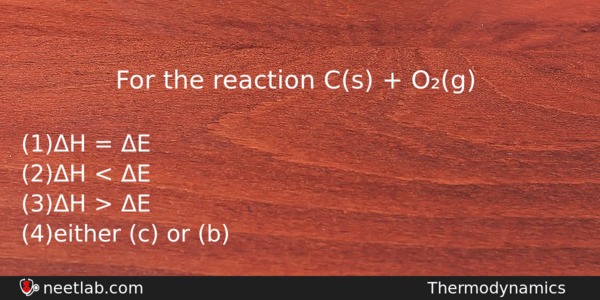| ⇦ | 
| ⇨ |
For the reaction C(s) + O₂(g)
Options
(a) ΔH = ΔE
(b) ΔH < ΔE
(c) ΔH > ΔE
(d) either ΔH > ΔE or ΔH < ΔE
Correct Answer:
ΔH = ΔE
Explanation:
In the reaction C(s) + O₂(g) → CO₂(g), there is no change in the number of moles of gaseous components (Δn = 1 – 1 = 0).
As ΔH = ΔE + ΔnRT. Thus in this case ΔH = ΔE.
Related Questions: - Schiff’s reagent is
- The best method for the separation of naphthalene and benzoic acid from their
- If the enthalpy change for the transition of liquid water to steam
- The oxidation number of nitrogen in (N₂H₅)⁺ is
- Which of the following elements are analogous to the lanthanides
Topics: Thermodynamics
(179)
Subject: Chemistry
(2512)
Important MCQs Based on Medical Entrance Examinations To Improve Your NEET Score
- Schiff’s reagent is
- The best method for the separation of naphthalene and benzoic acid from their
- If the enthalpy change for the transition of liquid water to steam
- The oxidation number of nitrogen in (N₂H₅)⁺ is
- Which of the following elements are analogous to the lanthanides
Topics: Thermodynamics (179)
Subject: Chemistry (2512)
Important MCQs Based on Medical Entrance Examinations To Improve Your NEET Score
18000+ students are using NEETLab to improve their score. What about you?
Solve Previous Year MCQs, Mock Tests, Topicwise Practice Tests, Identify Weak Topics, Formula Flash cards and much more is available in NEETLab Android App to improve your NEET score.
Share this page with your friends

Leave a Reply